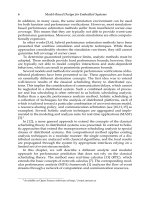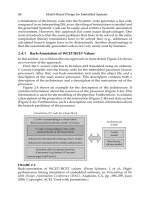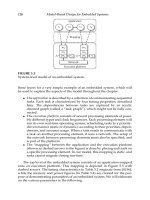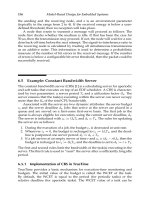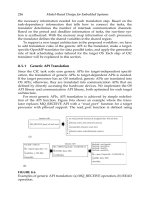Model-Based Design for Embedded Systems- P56 ppsx
Bạn đang xem bản rút gọn của tài liệu. Xem và tải ngay bản đầy đủ của tài liệu tại đây (509.28 KB, 10 trang )
Nicolescu/Model-Based Design for Embedded Systems 67842_C016 Finals Page 526 2009-10-2
526 Model-Based Design for Embedded Systems
The execution of continuous model, described by differential and algebraic
equations, requires solving these equations numerically. A widely used class
of algorithms discretizes the continuous time line into an increasing set of
discrete time instants, and numerically computes values of state variables at
these ordered time instants. The next state of derivative systems cannot be
specified directly but the derivative functions are used to specify the rate of
change of state variables [34].
The execution of a continuous system raises problems because given a
state q
k
and a vector x for a time t
k
, the derivative offers information only
for dq
k
/dt but not the system’s behavior over time. For a nonzero interval
[t
k
, t
k+1
] the computation has to be realized without knowing the behavior in
the interval (t
k
, t
k+1
). This problem can be solved using numerical integration
methods. Some of the most commonly used methods are
• Euler method that consists in signal integration:
dq(t)
dt
=
lim
h →∞
q(t + h) − q(t)
h
.
For an h small enough (in order to obtain accurate results), the following
approximation can be used:
q(t + h) = q(t) + h ∗
dq(t)
d(t)
This solution has low efficiency and does not have stability problems for
small enough h and it is very robust [34].
• Causal methods that are a linear combination of states and derivative
values at time instants with coefficients chosen to minimize errors from
the computed estimate to the real value [34].
This solution has high efficiency but it has stability and robustness
problems.
• Noncausal methods that use “future” values of states, derivative, and
inputs. In order to do that the model is executed past the needed time
and the values that are necessary are stored to estimate the present
values [34].
16.4 Methodology
This section introduces a methodology for the design of continuous/dis-
crete co-simulation tools (as shown in Figure 16.3). To enable the design of
co-simulation tools, this methodology presents several steps that are inde-
pendent of the simulation tools used for the continuous and discrete
Nicolescu/Model-Based Design for Embedded Systems 67842_C016 Finals Page 527 2009-10-2
Generic Methodology for the Design 527
Generic stage
Definition of the operational semantics
for the synchronization
Distribution of the synchronization
functionality to the interfaces
Formalization and verification of the
interfaces behavior
Definition of the internal architecture of
the interfaces and the library elements
Simulation
tools analysis
Library elements
implementation
Implementation
validation
Implementation
stage
FIGURE 16.3
A generic methodology for the design of C/D co-simulation tools.
components of the system. During these generic steps, the co-simulation
interfaces are defined in a conceptual framework; their functionality and
the internal structure of simulation interfaces are expressed using exist-
ing formalisms and temporal logic. After the rigorous definition of the
required functionality for simulation interfaces, the designer will start the
steps related to the implementation.
The main steps of the proposed methodology (illustrated in Figure 16.3)
can be divided into two stages:
1. A generic stage with the following actions:
• Definition of the operational semantics for the synchronization in
continuous/discrete global execution models.
• Distribution of the synchronization functionality to the simulation
interfaces.
• Formalization and verification of the simulation interfaces behavior.
• Definition of the library elements and the internal architecture of the
simulation interfaces.
2. An implementation stage with the following actions:
• The analysis of the simulation tools for the integration in the co-
simulation framework.
• The implementation of the library elements specific to different sim-
ulation tools.
Nicolescu/Model-Based Design for Embedded Systems 67842_C016 Finals Page 528 2009-10-2
528 Model-Based Design for Embedded Systems
This section focuses on the generic stage and its steps will be detailed in
the next subsections. A possible implementation stage will be detailed
further in Section 16.8.
16.4.1 Definition of the Operational Semantics for the
Synchronization in Continuous/Discrete Global
Execution Models
The first step of the methodology for co-simulation tools design is the defini-
tion of the operational semantics for the synchronization in continuous/dis-
crete global execution models. An operational semantics gives a detailed
description of the system’s behavior in mathematical terms. This model
serves as a basis for analysis and verification. The description provides a
clear language independent model that can serve as a reference for different
implementations.
The operational semantics for continuous/discrete systems requires the
rigorous representation of the relation between the simulators (communica-
tion/synchronization and data exchanged between the continuous and the
discrete simulators) as well as their high level and dynamic representations.
16.4.2 Distribution of the Synchronization Functionality to the
Simulation Interfaces
Based on the operational semantics, we can now define the synchronization
functionality between the continuous and the discrete simulators. This func-
tionality is insured by the interfaces that are the link between the different
execution models and the co-simulation bus (see Figure 16.1). They are each
in charge with a part of the synchronization between the two models. To
ensure system’s flexibility, the synchronization functionality has to be dis-
tributed to the simulation interfaces. Moreover, each computation step has
to be thoroughly specified.
16.4.3 Formalization and Verification of the Simulation Interfaces
Behavior
The formalization and verification of the simulation interfaces behavior stage
can be roughly divided in three steps: formalization (that can be the formal
specification of the heterogeneous system), the validation by model simula-
tion, and the formal verification. The two main techniques that can be used
for the formal verification of the interfaces are [36]:
• Model checking, where the system descriptions are given as automata,
the specification formulas are given as temporal logic formulas, and
the checking consists of the verification which ensures that all models
of a given system description satisfy a given specification formula. It
Nicolescu/Model-Based Design for Embedded Systems 67842_C016 Finals Page 529 2009-10-2
Generic Methodology for the Design 529
focuses mainly on automatic verification. Completeness and termination
guarantee of model checking are some features of this technique, as well
as it enables the tool to guarantee the correctness of a given property,
or produce a counterexample otherwise.
• Theorem proving, where the verification plan is manually designed
and the correctness of the steps in the plan is verified using theo-
rem provers. Completely automatic decision procedures are impos-
sible because the input language (the model and the specification) is
of higher order logic and that eliminates the decidability. Moreover,
everything has to be translated in higher order logic, and, therefore, the
structure of the system may be lost and its representation can become
large and difficult to work with.
Considering that the system is dynamic, it is necessary to use a formal-
ism that allows the expression of dynamic properties (the state of a system
changes and by consequence the properties of the state also change). The
temporal logic handles formalization where the properties evolve over time
and in general uses:
• Propositions that describe the states (i.e., elementary formulas and log-
ical connectors)
• Temporal operators that allow the expression of the properties of the
states successions (called executions)
The differences between the logics are in terms of temporal operators and
objects on which they are interpreted (such as sequences or state trees) [25].
The most commonly used logics are Linear Temporal Logic (LTL), Com-
putation Tree Logic (CTL* and CTL, both of them untimed temporal log-
ics) and their timed extensions TCTL and Metric Interval Temporal Logic
(MITL).
• CTL* allows the use of all temporal and branching operators but the
property verification is very complex. For this reason, most of the tools
actually used allow the verification of fragments of CTL*.
• LTL is a fragment of CTL* that excludes the trajectory quantifiers. In
this case only the trajectory predicates are considered. LTL does not
provide a means for considering the existence of different possible
behaviors starting from a given state (sequential) 0.
• CTL is also a fragment of CTL* and it is obtained when every occur-
rence of a temporal operator is immediately preceded by a branching
operator. In the case of CTL we have state trees.
• TCTL is a timed temporal logic that is an extension of CTL obtained by
subscribing the modalities with time intervals specifying time restric-
tions on formulas.
For our formal model, the properties that need to be checked are branching
properties that are expressed using CTL or TCTL logics.
Nicolescu/Model-Based Design for Embedded Systems 67842_C016 Finals Page 530 2009-10-2
530 Model-Based Design for Embedded Systems
Continuous/discrete
global simulation model
Continuous
model
Discrete
model
Discrete domain simulation
interface-DDI
Continuous/discrete
simulation interface
Elements from the co-simulation library
Co-simulation
bus
Continuous domain
simulation interface-CDI
Atomic model
CDI
Atomic model
CDI
Atomic model
CDI
Atomic model
CDI
Atomic model
CDI
Atomic model
CDI
Atomic model
CDI
Atomic model
CDI
Atomic model
CDI
FIGURE 16.4
Hierarchical representation of the generic architecture of the co-simulation
model.
16.4.4 Definition of the Internal Architecture of the Simulation
Interfaces
The formalization of the simulation interfaces behavior step is naturally fol-
lowed by the definition of their internal architecture. This definition eases the
automatic generation of the simulation interfaces. We present in Figure 16.4
the hierarchical representation of the global simulation model used in our
approach.
At the top hierarchical level, the global model is composed of the contin-
uous and discrete models and of the C/D simulation interface required for
the global simulation [12].
The second hierarchical level of the global simulation model includes the
domain specific simulation interfaces and the co-simulation bus in charge of
the data transfer between these interfaces.
The bottom hierarchical level includes the elements from the co-
simulation library that are the atomic modules of the domain specific sim-
ulation interface. These atomic components implement basic functionalities
of the synchronization model.
16.4.5 Analysis of the Simulation Tools for the Integration
in the Co-Simulation Framework
The considerations presented in the previous steps of the methodology show
that specific functionalities are required for the co-simulation of continu-
ous and discrete modes. Therefore, the integration of a simulation tool in
Nicolescu/Model-Based Design for Embedded Systems 67842_C016 Finals Page 531 2009-10-2
Generic Methodology for the Design 531
the co-simulation environment requires their analysis. Thus, in the case of
continuous simulator integration in the co-simulation tool, this simulator has
to provide application programming interfaces (APIs) enabling the following
controls:
• Detection and location of state events
• Setting break points during differential equation solving
• Online update of the breakpoints settings
• Sending processing results and information for synchronization (i.e.,
the time step of the state event) to the discrete simulator. This generally
implies the possibility to integrate C-code and Inter-Process Commu-
nications (IPC).
For the integration of a discrete simulator in the co-simulation tool, the sim-
ulator has to enable the addition of the following functionalities:
• Detection for the end simulation cycle
• Insertion or retraction of new events (state events) in the scheduler’s
queue. This must be done before the advancement of the simulator
time
• Sending processing results and information for synchronization to the
continuous simulator (i.e., the time stamp of its next discrete event).
16.4.6 Implementation of the Library Elements Specific to
Different Simulation Tools
The last step of the methodology for the design of co-simulation tools for
continuous/discrete systems is the implementation of the library elements
that are specific to different simulation tools. This step depends highly on the
simulation tools chosen in the previous step, the analysis of the simulation
tools.
16.5 Continuous/Discrete Synchronization Model
The methodology focuses mostly on the co-simulation interfaces. One of the
most important functions of the interfaces is providing the synchronization
that is defined as coordination with respect to time. Thus, for a better under-
standing of the methodology it is very important for one to comprehend the
synchronization model. The synchronization between the continuous-time
domain and the discrete-event domain is realized using a canonical algo-
rithm as it was presented in [11]. For a rigorous synchronization the discrete
kernel has to detect the events generated by the analog (continuous) solver
Nicolescu/Model-Based Design for Embedded Systems 67842_C016 Finals Page 532 2009-10-2
532 Model-Based Design for Embedded Systems
and the continuous solver must detect the scheduled events from the discrete
kernel.
The events exchanged between the discrete and the continuous simula-
tors are [7]:
• Occurred/scheduled events that are timed events scheduled by the dis-
crete simulator.
• State events that are unpredictable events generated by the continuous
simulator. Their time stamp depends on the values of state variables
(e.g., a zero-passing or a threshold crossing).
For the discrete event processes, time does not advance during the execution.
The next execution time is the time of the next event in the event queue. The
execution of the analog solver advances the simulation time. Let t
k
be the
synchronization time for the discrete kernel and the analog solver. The ana-
log solver advances to the next synchronization time t
k+1
, known in advance
from the digital kernel. At this point the analog solver suspends while the
digital kernel resumes and the events in t
k+1
are executed. If a state event
occurs in the time interval [t
k
, t
k+1
], the analog solver suspends to allow the
digital kernel to take this event into consideration. This way the analog solver
and the digital kernel are synchronized again.
Figure 16.5a presents the synchronization model in the C/D co-
simulation interface without taking into consideration the state event occur-
rence. The state event is taken into consideration in Figure 16.5b.
At a given time, the discrete simulator is in the state (x
dk
,t
k
). At this point,
the discrete simulator has executed all the processes sensitive to the event
with the time stamp t
k
and sends the time of the next event t
k+1
and the data
to the continuous simulator and the context is switched from the discrete to
the continuous simulator before advancing the time.
(a)
No state event
Discrete
simulator
Continuous
simulator
(Data)
3
5
1
(Data, t
k+1
)
(x
dk
, t
k
)
4
(x
dk+1
, t
k+1
)
(Data, t
k+2
)
2
(x
ck
, t
k
)
(q, t
k+1
)
State event
(x
dk ,
t
k
)
(x
dse,
t
se
)(x
dk΄
, t
k΄
)
t
4
1
3
5
(Data, t
k΄
)
(Data, t
k+1
)
(Data, t
se
)
(x
ck
, t
k
)
2
(se, t
se
)
(x
ck΄
, t
k΄
)
t
(b)
Scheduled event
State event
Reached event
Synchronization
Simulation step
FIGURE 16.5
The synchronization model in the C/D simulation interface without state
event (a) or with state event (b).
Nicolescu/Model-Based Design for Embedded Systems 67842_C016 Finals Page 533 2009-10-2
Generic Methodology for the Design 533
The state of the continuous simulator is (x
ck
,t
k
) and the advance in time of
the simulator cannot be further than t
k+1
, the time sent by the discrete simu-
lator. Consequently, the continuous simulator computes signals by resolv-
ing the system’s equations until it reaches with accuracy the time t
dk+1
,
updates signals with the values calculated at this time its new state being (q,
t
k+1
), sends the new data, and the context is switched to the discrete model
(arrow 3). The discrete simulator will also advance to the time t
k+1
(arrow 4)
and the cycle restarts as shown in Figure 16.5a. The continuous model may
generate a state event. In this case, it updates signals with the values calcu-
latedatthistime,t
se
in Figure 16.5b its new state being, (se, t
se
), it indicates
its presence by sending the state event’s time stamp (t
se
) and the correspond-
ing data to the discrete model before switching the simulation context. The
discrete model has to be able to detect this event, by advancing the local time
to the time stamp, and to execute the processes that are sensitive to it and
arrive at the state (x
dse
, t
se
).
16.6 Application of the Methodology
This section proposes a possible application of the methodology that was
proposed in Section 16.4. First, the basic concepts that are used in our specific
methodology are introduced: DEVS and timed automata [1].
16.6.1 Discrete Event System Specifications
DEVS is a formalism supporting a full range of dynamic system represen-
tation, with hierarchical and modular model development. The abstraction
separates modeling from simulation and provides atomic models that can be
used to build complex models that allow the integration of continuous and
discrete-event models [34]. It also provides all the mechanisms for the defini-
tion of an operational semantics for the continuous/discrete synchronization
model, the high level representation of the global formal model.
A DEVS is defined as a structure [34].
DEVS = < X, S, Y, δ
int
, δ
ext
, λ, t
a
> where
X = {(p
d
, v
d
)|p
d
∈ InPorts, v
d
∈Xp
d
}setofinput ports and their values in
the discrete event domain,
S—set of sequential states
Y ={(p
d
, v
d
)|p
d
, ∈OutPorts, v
d
∈Yp
d
} set of output ports and their values
in the discrete event domain.
δ
int
: S→ S the internal transition function
δ
ext
: QxX→ S the external transition function, where:
Q ={(s,e)|s ∈S,0≤e ≤ta(s)} set of total state,
e is the time elapsed since the last transition
Nicolescu/Model-Based Design for Embedded Systems 67842_C016 Finals Page 534 2009-10-2
534 Model-Based Design for Embedded Systems
λ : S→Y output function
t
a
:S→R
+
0,∞
set of positive reals with 0 and ∞.
The system’s state at any time is s. There are two possible situations:
• Case 1—where we assume that no external events occur. In this case
the system stays in this state s for the time t
a
(s). When the elapsed
time e equals t
a
(s) (that is the time allocated for the system to stay in
state s), the system outputs the value λ(s).Thestates changes to the
state s as a result of the transition δ
int
(s). We emphasize here that the
output is possible only before the internal transitions. We propose
the definition of this type of transition using the following rule of the
form
Premises
Conclusions
:
e=t
a
(s)∧s
=δ
int
(s)
(s,e)
!λ(s)
−→(s
,0)
, where “!” represents the send oper-
ator.
• Case 2—where there is an external event x before the expiration time,
t
a
(s) (the system is in state (s,e), with e ≤ t
a
(s)), the system’s state
changes to state s
as a result of the transition δ
ext
(s, e,x). For the
definition of this type of transition, we propose the following rule:
e≤t
a
(s)∧s
=δ
ext
(s,e,x)
(s,e)
?x
−→(s
,0)
, where “?” represents the receive operator.
Thus, the internal transition function dictates the system’s new state when no
external events occurred since the last transition while the external transition
function dictates the system’s new state when an external event occurs—this
state is determined by the input x, the current state s and the time period
during which the system has been in this state, e. In both cases the system is
then in some new state s
with some new expiration time t
a
(s
).
We also give here DEVS coupled models as defined by the same formal-
ism. For the case where we have ports, the specification includes external
interfaces with input and output ports and values and coupling relations:
• N =(X,Y,D,{M
d
|d ∈ D}, EIC,EOC,IC) where:
• X ={(p, v)|p ∈ InPorts, v ∈ Xp}setofinput ports and values
• Y ={(p, v)|p ∈OutPorts, v ∈Yp}setofoutput ports and values
• D = set of components names
• M
d
=(X
d
, S, Y
d
, δ
int
, δ
ext
, λ, t
a
) is a DEVS with X
d
, Y
d
the set of
input/output ports and values
• EIC (External Input Coupling) = the coupling between the input in the
coupled model and the external environment
• EOC (External Output Coupling) = the coupling between the output
from the coupled model and the external environment
• IC (Internal Coupling) = the coupling between the modules that com-
pose the coupled module [12]
In our work we used the parallel DEVS coupled formalism. Each module
composing the interface performs a different task according to the synchro-
nization model specified in Section 16.5.
Nicolescu/Model-Based Design for Embedded Systems 67842_C016 Finals Page 535 2009-10-2
Generic Methodology for the Design 535
16.6.2 Timed Automata
In this section we briefly introduce timed automata. Chapter 14 gives a more
detailed presentation of this formalism. A timed automaton [1] is the for-
malism for modeling and verification of real time systems. It can be seen as
classical finite state automata with clock variables and logical formulas on
the clock (temporal constraints) [3]. The constraints on the clock variables
are used to restrict the behavior of the automaton. The logical clocks in the
system are initialized to zero when the system is started and then increase
at the uniform rate counting time with respect to a fixed global time frame.
Each clock can be separately reset to zero. The clocks keep track of the time
elapsed since the last reset [1]. There are two types of clock constraints: con-
straints associated with transitions and constraints associated with locations.
A transition can be taken when the clocks’ values satisfy the guard labeled on
it. Figure 16.6 illustrates an example of a timed automaton. The constraints
associated with locations are called invariants and they specify the amount
of time that may be spent in a location. The invariant “true” for a location
means there are no constraints for the time spent in the location.
The process shown in Figure 16.6 starts at the location p with all its clocks
(x and y) initialized to 0. The values of the clocks increase synchronously
with time at the location q.
At any time, the process can change the location following a transition
p
g;a;r
−→ q if the current values of the clocks satisfy the enabling condition g
(guard). A guard is a Boolean combination of integer bounds on clocks and
Guard
y<= 4;
b?;
x := 0
Action Reset
Invariant
x<= 4
c; y := 0
Legend
x= 5; b!
Clocks: {x, y}
! Operator send
? Operator receive
Transition
p
Start location
p
q
Location
q
FIGURE 16.6
Example of a timed automaton.

